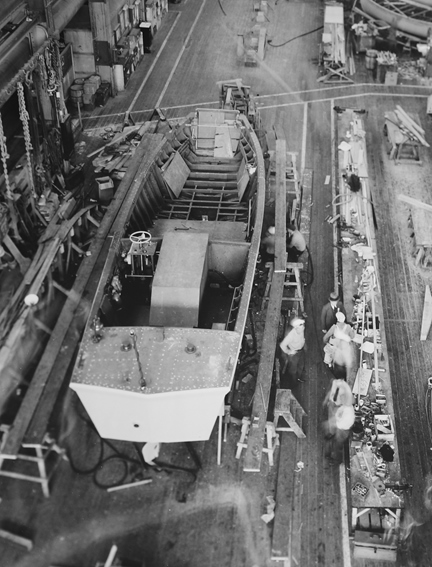|
Chris-Craft
Main Page Navy
LCVP Contract Page
Chris-Craft in World War Two
Landing Craft Construction Photos
This page added 3-15-2020.
All of the photos on this page are courtesy of the Algonac-Clay
Township Historical Society.
Unknown type of landing craft:
The next two photos show the aft section of a landing craft.
Because all the rest of the photos are of an LCP(L) or LCP(R)s, it is
assumed to be one of the two. From the rear, it is hard to tell.


LCP(L): This is the only photo of
an LCP(L).

This LCP(L) is powered by a Gray Marine
6HN9/Detroit Diesel 6-71 engine.
LCP(R) Longitudinal Knock-down Reassembly:
This is a collection of photos that show a modular build up of an
LCP(R). The boat has a non-standard location of the coxswains
position next to the engine. This demonstrates the re-building of
the boat after it has been disassembled after being knocked-down for
shipment in the longitudinal configuration.


It appears that this group of photos shows
how the LCP(R) can be built up after being shipped in this knocked-down
form. At least that is what I get out of it. The
descriptions on the photos did not say.

The workers are getting ready to install a
Gray Marine 6HN9/Detroit Diesel 6-71 engine.


Mounted to the front of this assembly are
two hand bilge pumps.

Here the transom is being installed.
The emergency steering mechanism can be seen. This was also
included in the LCP(L), LCV and LCVP.


This is new to me. I have never seen a
construction photo of a landing craft where the sides came as one piece
and then were installed like this.
There is an alternate explanation for this.
The LCP(R) was built up in the traditional manner and then cut apart
like it was shown in the second photo. This series of photos shows
how it is put back together after being shipped in pieces.

Glue is used between the side and the
bottom. Some of it can be seen. Some of the nails have
already been driven in.

This is the only photo that gave evidence
that the boat was being put back together. Without this photo, it
could actually be the reverse process of taking it apart for shipment in
a knocked-down condition.



This photo shows the exhaust side of the
Gray Marine 6HN9/Detroit Diesel 6-71 engine. The voltage
regulator, starter and DC generator were all built by the Delco-Remy
Division of General Motors. The U.S. Navy provided a plant in
Kings Mill, OH in 1944-45 for Delco-Remy to add capacity for starting motors for landing craft like this one.

The worker is adding the bulkhead at the
rear of the boat where the fuel tanks will be located. The
bulkhead has a circular cut-out for the exhaust pipe from the diesel
engine.

The fuel tanks and fuel lines can be seen in
this photo. The filler tubes for pouring in diesel fuel are at the
top of each tank.


The photo below was on the back side of this
photo,
and is the description of the of the contents inside the two crates on
the flatcar. It is LCP(R) with
hull number C-88002 that is being shipped as a longitudinal knock-down.
This would be the method just shown above.

LCP(R) Transverse Knock-down Reassembly:
This series of photos shows an LCP(R) being reassembled after it was
taken apart in three sections. This is another method of doing a
knock-down for shipment. This appears to be a demonstration of how
easy it is to put the boat back together with a minimum of equipment.
This is a simpler method than the one above.

This is the center section with the front
ramp section loaded into it.

This is the center section after the ramp
section has been removed.

This is the rear section. Note the
hand operated bilge pumps on the bulkhead.

The rear section is being manhandled into
position to assemble with the center section.

A small crane or a wrecker truck is needed
to lift the ramp section into place.


Workers put the finishing touches on the
LCP(R) by installing the combing.

As the photo below shows, this type of
knock-down shipment is the transverse method. The two LCP(R)s were
two hull numbers apart and shipped differently.

|





























